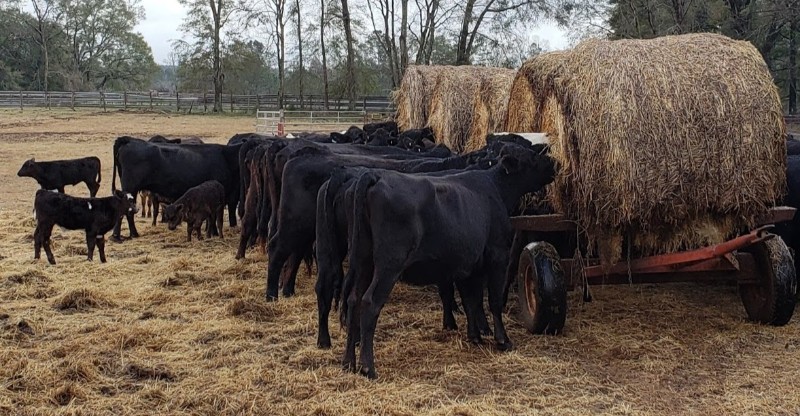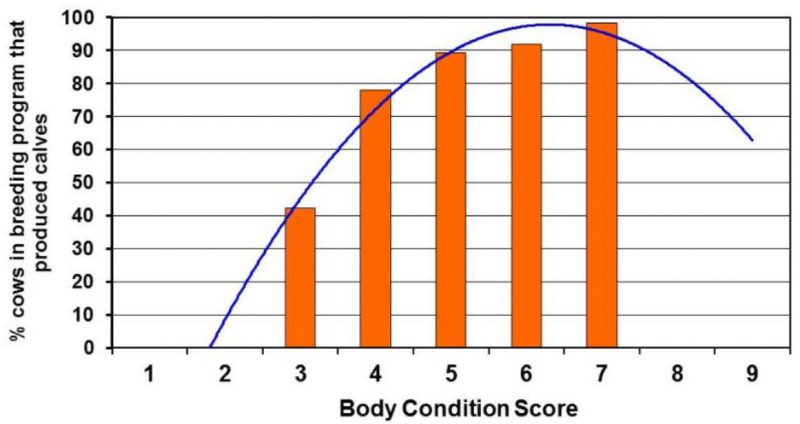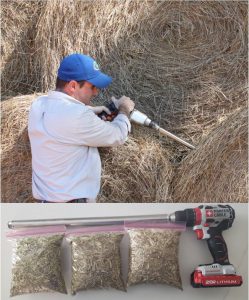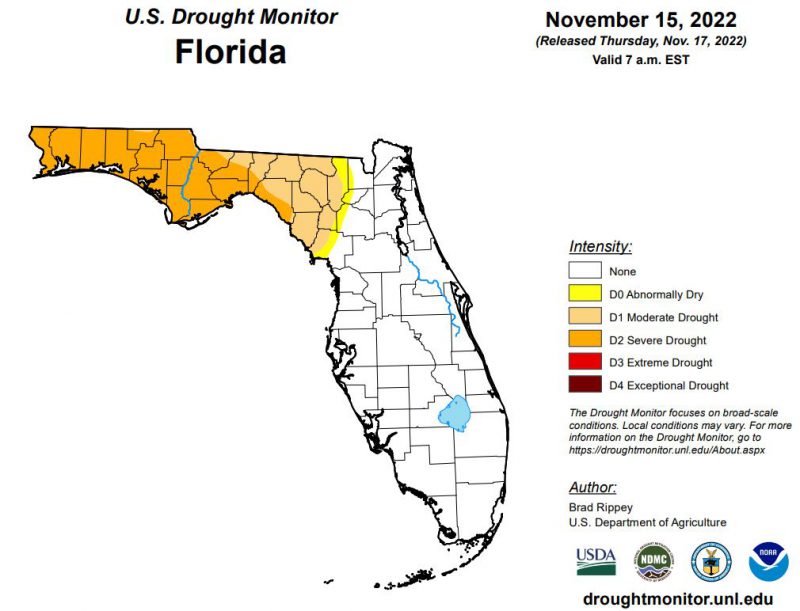
It’s not even Thanksgiving, and throughout the Panhandle a lot of hay has already been fed. This winter feeding season will not be without challenges, be sure to monitor cows closely and provide needed supplementation for low quality hay. Photo Credit: Mark Mauldin, UF/IFAS
There’s a perfect storm of sorts developing , so cattle producers throughout the Panhandle need to be prepared to weather it. Thankfully, the storm taking shape is not a tropical system spinning up in the Gulf, this storm relates to the mounting challenges associated with meeting the nutritional demands of your cattle this winter.
The current situation, as I see it: We started consuming our tight supply of low-quality hay earlier than normal and the ability of cool-season forages to ride to our rescue is quite questionable at this point.
Put simply, this past summer was somewhere between bad and horrible in terms of opportunities to make quality hay. It rained, seemingly constantly, until it stopped and then it didn’t rain a drop for 60 days ushering in an early fall. Poor weather combined with staggeringly high fertilizer prices have available hay in somewhat short supply. The hay on the market or in the barn, is more expensive (either in terms of cash or input costs) and likely lower quality than what we are accustomed to utilizing. Let’s be honest, this part of the world is not known for its high-quality hay, even on a good year. Add to that a lot of fields that were unfertilized, were way too mature when it finally got dry enough to cut them, or both and the quality situation looks dismal.
As previously mentioned, when it finally stopped raining, it really stopped. We are dry (see figure 1 below) and have been for quite a while. Dry conditions plus a few frosty mornings in mid-October cost us quite a bit of late season grazing from our summer pastures. This loss of late summer/early fall forage production means more days when cattle are dependent on conserved forages to meet their nutritional demands. Combined with the fact that we put up fewer tons of dry matter (DM) than “normal” means we may have issues relating to quantity available in addition to the concerns about quality previously mentioned.
The persistently dry conditions may also have a substantial negative effect on cool-season forage production. Prudence dictates that you wait for moisture before planting. However, due to shorter days and cooler soil and air temperatures, later planted cool-season forages are slower to establish and take longer to reach grazing height than those planted in a timelier manner. Dry conditions after planting/emergence can also greatly limit forage production. Tying this to the previous points, less than ideal quality hay is not all that unusual, but without an adequate supply of high-quality cool-season forages to offset nutritional shortfalls the situation becomes increasingly concerning, not to mention the additional pressure the absence of cool-season forages would put on an already tight supply of available hay.
So why am I sharing all this fairly depressing news? Unfortunately, it’s not because I have a “sliver bullet” solution to share. To the contrary, it’s because managing through these kinds of situations is challenging and not often done well without advanced thought and planning. The situation described above, coupled with some recent conversations I’ve had about managing cows that are already losing condition, prompted this reminder about the importance of closely monitoring our herds’ bdoy condition score (BCS) and managing available nutrition accordingly.
When managing through challenging nutritional situations, it is of the utmost importance to monitor cattle Body Condition Score (BCS) and stay in front of potential problems. Cattle are very hardy animals and can bounce back from a lot, but in the long run it is generally cheaper and more efficient to maintain a cow at a reasonable BCS (4+) then it is to provide her with the increased nutrition she’ll need to regain substantial amounts of lost weight. This is especially true when you factor in the negative effects lower BCS has on all metrics of reproductive performance.
If cattle are losing BCS before calving, available nutrition needs to be increased. Nutritional demands increase considerably once lactation begins and some loss of BCS is to be expected. However, if cows are already losing condition before calving, the level of condition lost post calving will likely be unacceptable, resulting in greatly reduced reproductive performance in the subsequent production cycle. I acknowledge that feeding cows is expensive, but there is a lot of truth in the old adage “You can’t starve a profit out of a cow“. You either pay for nutrition now or loose income and pay for nutrition later. The article Implications Of Cow Body Condition Score on Productivity does an excellent job exploring this concept.

Relationship of cow body condition score to calving percentage, the number of calves born from the total number of cows that were included in the breeding program. From AN319 Implications Of Cow Body Condition Score on Productivity.
As previously discussed, the hay you’ve got probably isn’t great and if you run out, what you’ll be able to purchase later will likely be even worse. To adequately meet the nutritional demands of your herd you will almost certainly have to supplement their hay with an additional feed source and/or cool-season forages. Just because there is hay available, doesn’t mean the cows are sufficiently fed. Cattle can starve to death with a full belly (due to insufficient nutrient density in the feedstuff). To determine the nutritional value of your hay, you can have a laboratory analysis performed – this is a quick and easy process, just call your County’s UF/IFAS Extension Office and the Ag Agent will help you get it taken care of. Note: to be meaningful you will need a separate analysis of each cutting / lot purchased.

Hay samples can be easily collected using a drill driven sampling tool. Bagged samples are sent to a laboratory for analysis. Photo Credit: Mark Mauldin
The information from the lab can help you determine to what degree your hay will need to be supplemented and how to most efficiently allocate different cuttings of hay. Matching higher quality hay to cattle with higher nutritional demands always makes nutritional management simpler. A simple example to help illustrate the point: You have two cuttings of hay in the barn; lab analysis indicates that the second cutting is somewhat higher in quality than the first. Feed the first cutting to the cows while they are pregnant and hold the higher quality cutting until they start calving. It doesn’t sound like much, but those kinds of adjustments can make a big difference in cow performance and/or amount of supplement needed.
Even with proper hay allocation addressed, supplementation is still a major concern. The nutritional requirements of cattle are well documented. If you know:
- Body weight (BW) of your cows (get a scale)
- Stage of production (pregnant, lactating, etc.) – observation/records
- The nutrition available in your forage (TDN, CP, etc.) – from lab analysis
- Anticipated consumption rate of hay (expressed in %BW) – from lab analysis
You can calculate exactly how much energy and/or protein will need to be supplemented. This information can be compared to a nutritional analysis of any potential feedstuff to determine its suitability as a supplemental feed (amount needed, cost per head per day, etc.). Considering current commodity and fuel prices it is doubtful that you’ll find a “cheap” supplement that will meet your herd’s needs, but it never hurts to run the numbers on any and all options. Contact me or your County’s UF/IFAS Extension Office for help with this process. It’s not hard, but there is quite a bit of math and we’re happy to help. The UF Hay Balancer can also be useful in developing an efficient supplementation strategy.
Free choice supplements (liquids, pressed tubs, etc.) are very popular because they are simple and convenient to feed. These kinds of products can be very effective, but because they are fed free choice and depend on a limiter (physical or otherwise) to throttle consumption, the math mentioned above needs to be run on these products also to help ensure consumption is at least close to where it needs to be. Over consumption can get rather expensive, while under consumption can result in loss of BCS and serious cattle performance issues. Keep in mind that as hay/forage quality decreases more supplement is required. It may get expensive, but cattle need to be able to eat as much as necessary to meet their needs. Make sure you’ve had your hay analyzed and have done all the math correctly before you assume over consumption and take steps to limit consumption of supplements intended to be fed free choice.
At this stage in the game, what steps can be taken to help get ready for the storm?
1) Honestly and critically evaluate your operation’s current status.
- Do you have enough hay?
- How bad is the quality? Don’t guess, get it analyzed.
- What is your herd’s average BCS today? Are they holding or losing condition?
- We are out of the recommended planting window for cool season forages, what do you have planted? How good does it look? When will it be ready to graze?
You may not like the answers to some of these questions but understanding where you are is always the first step in getting where you want to be.
2) Spend the time, make the necessary calls and really scrutinize available supplementation options.
Invest the time now to save money and cow performance in the long run.
3) Begin supplementation before cattle start losing BCS.
Stay out in front of potential problems. In terms of nutritional management, you don’t want to play catch-up over the winter, especially the way this winter feeding season is shaping up.
4) Continually monitor herd BCS and supplement consumption. Take steps to adjust available nutrition as needed.
Storms aren’t fun but they pass, and they are a lot easier to get through if you take steps to prepare in advance, instead of waiting until you are in the midst before acknowledging the situation. If you would like to discuss any of the topics addressed in the article in greater detail don’t hesitate to call or email.

